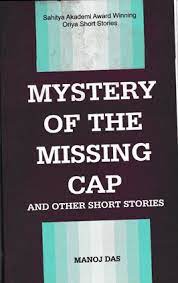MYSTERY OF YHE MISSING CAP
Introducing the Author
Manoj Das is one of the foremost writers of the generation of
Indian writers. It goes without saying that he is the Indian Chekhov in his
awareness of human misery and ironies of life, in the art of exposing all that
is vulgar, shameful and pitiable. The basic material of his stories is obtained
from his observation of human experience. Like Maupassant and Chekhov, he
possesses a ‘sublime curiosity’ about human affairs in abundance but with great
skill and psychological subtlety he succeeds in recreating that experience and
revealing its underlying significance. His stories are refreshingly free from
the elements of horror, sex and violence, the crudities which makes most of the
modern writings morbidly distasteful and keep the reader’s mind sullenly down.
His themes are essentially Indian, evoking Indian scene and atmosphere.
ये गुम होने का रहस्य
लेखक का परिचय
मनोज दास भारतीय लेखकों की पीढ़ी के अग्रणी लेखकों में से एक हैं। यह बिना कहे चला जाता है कि वह भारतीय चेखव है जो मानवीय दुखों और जीवन की विडंबनाओं के बारे में जागरूकता में है, जो कि अश्लील, शर्मनाक और दयनीय है। उनकी कहानियों की मूल सामग्री उनके मानवीय अनुभव के अवलोकन से प्राप्त होती है। मौपसंत और चेखव की तरह, उनके पास मानवीय मामलों के बारे में प्रचुर मात्रा में 'उत्कृष्ट जिज्ञासा' है, लेकिन महान कौशल और मनोवैज्ञानिक सूक्ष्मता के साथ वह उस अनुभव को फिर से बनाने और इसके अंतर्निहित महत्व को प्रकट करने में सफल होते हैं। उनकी कहानियाँ डरावनी, सेक्स और हिंसा के तत्वों से ताज़ा रूप से मुक्त हैं, जो कि अधिकांश आधुनिक लेखन को रुग्ण रूप से अरुचिकर बनाती हैं और पाठक के दिमाग को नीचे रखती हैं। उनके विषय अनिवार्य रूप से भारतीय हैं, जो भारतीय दृश्य और वातावरण को उद्घाटित करते हैं।
Manoj Das is traditional in form and technique, but modern in idea and sensibility. He is original in devising plot, invention the subtle interpretation of things. His language is lucid and clear, tales, candid and fresh sparkling with humour and human essence.
मनोज दास रूप और तकनीक में पारंपरिक हैं, लेकिन विचार और संवेदनशीलता में आधुनिक हैं। वह साजिश रचने में मौलिक है, चीजों की सूक्ष्म व्याख्या का आविष्कार करता है। उनकी भाषा स्पष्ट और स्पष्ट, किस्से, स्पष्टवादी और हास्य और मानवीय सार के साथ ताजा जगमगाती है।
About the story
“Mystery of the Missing Cap’’ is a
brilliant comical, historical and realistic story which deals with a minister’s
visit to a village in Odisha. Here writer has thrown light on the rise of the
new class of patriots, the ministerial demigod like stance and style, the
sponsors like Moharana, the benevolent host and facetious Minister of Fisheries
and Fine Arts. The whole state of affairs has been mocked at end travestied by
the monkey. A district and unmistakable Odia flavour permeates the whole story.
The rural since is vividly portrayed with a plethora of details. Set in the
backdrop of the early days of independent India, the story gives a glimpse of
the socio-political picture and atmosphere of the then India. “Mystery of the
Missing Cap”, right from beginning to the end, glows with the radiance of a
delightful humour. Here the humour is at its peak almost in the manner of a
gala day celebration, observation of ritual. It is genuine, broad, farcical,
rustic, pesky and satirical.
कहानी के बारे में
"मिसिंग कैप का रहस्य" एक शानदार हास्यपूर्ण, ऐतिहासिक और यथार्थवादी कहानी है जो एक मंत्री की ओडिशा के एक गाँव की यात्रा से संबंधित है। यहां लेखक ने देशभक्तों के नए वर्ग के उदय पर प्रकाश डाला है, मंत्रिस्तरीय देवता जैसे रुख और शैली, मोहराणा जैसे प्रायोजक, परोपकारी मेजबान और मत्स्य पालन और ललित कला के मुखर मंत्री। बंदर ने आखिरकार पूरे मामले का मजाक उड़ाया है। एक जिला और अचूक उड़िया स्वाद पूरी कहानी में व्याप्त है। तब से ग्रामीण को विस्तृत रूप से विवरणों के साथ चित्रित किया गया है। स्वतंत्र भारत के शुरुआती दिनों की पृष्ठभूमि में सेट, कहानी तत्कालीन भारत की सामाजिक-राजनीतिक तस्वीर और माहौल की झलक देती है। "मिस्ट्री ऑफ़ द मिसिंग कैप", शुरू से अंत तक, एक रमणीय हास्य की चमक के साथ चमकता है। यहाँ हास्य अपने चरम पर है लगभग एक पर्व दिवस समारोह, अनुष्ठान के अवलोकन के रूप में। यह वास्तविक, व्यापक, हास्यास्पद, देहाती, अजीब और व्यंग्यपूर्ण है।
Summary
The writer takes us back to the early days of
post-independent India, when there was the rise of the new class of patriots.
Sri Moharana was burning example. He was not only rich, but also a benevolent
host. The village- patriot was ambitious of becoming a member of the
Legislative Assembly.
The writer refers to another politician- Babu Virkishore,
Minister of Fisheries and Fine Arts. His daily life comprised speech- making at
public receptions. Shri Moharana decided to accord a grand reception to the
minister in his village.
The writer vividly recounts the preparation for the
minister’s reception. He remembers how Sri Moharana gave a beautiful touch to
his ancestral cane chair. For fifteen days, the children of the village lower primary
school spent time in practising the welcome song. The narrator says that the
song still lingers in his memory. Moharana’s excitement knew bounds. He took
minute care of all the arrangements. Nervousness and uncertainty stared him in
the face.
The day Moharana and his sycophants waited for had come
at last. Alighting from his jeep the minister entered the very first welcome
gate on the outskirts of the village. Moharna garlanded in profusion. Instead
of getting into the jeep, the minster preferred to walk.
The writer gives a beautiful description of the
procession of the minister in the village. The minster walked slowly with the
heavy steps through the village street amidst the thunderous applause and
slogans in praise of the minister. Everyone in the village including the invalids
took part in it, Shouting slogans by turn and opening their mouths wide open.
The procession reached Moharana’s house. Moharana lavishly
entertained his guests. They were given tender coconut juice and treated to the
most fabulous lunch the narrator had even seen. The lunch Moharana had hosted
comprised twenty dishes that were arranged around the sweetened, ghee-backed
rice, tend the minister took rest in a cabin. The minister’s staffs were given
a separate accommodation for rest.
सारांश
लेखक हमें स्वतंत्रता के बाद के भारत के शुरुआती दिनों में ले जाता है, जब देशभक्तों के नए वर्ग का उदय हुआ था। श्री मोहराणा ज्वलंत उदाहरण थे। वह न केवल अमीर था, बल्कि एक परोपकारी मेजबान भी था। ग्राम-देशभक्त विधान सभा का सदस्य बनने का महत्वाकांक्षी था।
लेखक एक अन्य राजनेता- बाबू विरकिशोर, मत्स्य पालन और ललित कला मंत्री को संदर्भित करता है। उनके दैनिक जीवन में सार्वजनिक समारोहों में भाषण देना शामिल था। श्री मोहराणा ने मंत्री जी का उनके गांव में भव्य स्वागत करने का निर्णय लिया।
लेखक ने मंत्री के स्वागत की तैयारियों का बखूबी वर्णन किया है। उन्हें याद है कि कैसे श्री मोहराणा ने उनकी पुश्तैनी बेंत की कुर्सी को एक सुंदर स्पर्श दिया था। पंद्रह दिनों तक, गांव के निचले प्राथमिक विद्यालय के बच्चों ने स्वागत गीत के अभ्यास में समय बिताया। कथाकार का कहना है कि यह गीत आज भी उनकी स्मृति में है। मोहराणा का उत्साह सीमा जानता था। उन्होंने सभी व्यवस्थाओं का बारीकी से ध्यान रखा। घबराहट और अनिश्चितता ने उसे चेहरे पर देखा।
मोहराणा और उनके चाटुकारों को जिस दिन का इंतजार था, वह आखिरकार आ ही गया। अपनी जीप से उतरकर मंत्री गाँव के बाहरी इलाके में पहले स्वागत द्वार में दाखिल हुए। मोहरना ने जमकर माल्यार्पण किया। मिस्टर ने जीप में चढ़ने के बजाय चलना पसंद किया।
लेखक ने गाँव में मंत्री के जुलूस का सुंदर वर्णन किया है। मंत्री की प्रशंसा में तालियों की गड़गड़ाहट और नारों के बीच गाँव की गली से भारी कदमों के साथ मंत्री धीरे-धीरे चल पड़ा। इसमें विकलांगों सहित गांव के सभी लोग शामिल हुए, बारी-बारी से नारेबाजी की और मुंह खोलकर नारेबाजी की।
बारात मोहराणा के घर पहुंची। मोहराणा ने अपने मेहमानों का खूब मनोरंजन किया। उन्हें कोमल नारियल का रस दिया गया और वर्णनकर्ता द्वारा देखे गए सबसे शानदार दोपहर के भोजन के साथ व्यवहार किया गया। मोहराणा ने जो दोपहर के भोजन की मेजबानी की थी, उसमें बीस व्यंजन शामिल थे, जिन्हें मीठे, घी-समर्थित चावल के चारों ओर व्यवस्थित किया गया था, मंत्री ने एक केबिन में आराम किया। मंत्री के कर्मचारियों को विश्राम के लिए अलग से आवास दिया गया।












0 Comments
do you want to talk with us directly ?
this is working for you for your benefits